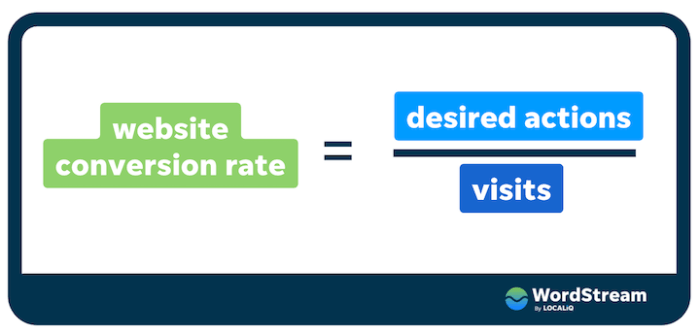Website Conversion Rates, the key to online success for businesses, are all about turning website visitors into customers. From analyzing user behavior to optimizing conversion paths, this topic dives deep into the strategies that drive results.
Introduction to Website Conversion Rates
Website conversion rates refer to the percentage of website visitors who take a desired action, such as making a purchase, signing up for a newsletter, or filling out a contact form. These rates are crucial for businesses as they directly impact the success of online marketing efforts and overall revenue generation.
Monitoring and improving website conversion rates is essential to optimize the performance of a website and increase the return on investment (ROI) of digital marketing campaigns. By analyzing user behavior, testing different strategies, and making data-driven decisions, businesses can enhance their conversion rates and ultimately drive more conversions.
In various industries, website conversion rates play a vital role in determining the effectiveness of online marketing initiatives. For e-commerce businesses, higher conversion rates mean more sales and revenue. In the service industry, such as healthcare or education, conversion rates indicate the success of lead generation efforts. Even in non-profit organizations, conversion rates measure the effectiveness of fundraising campaigns and donor engagement strategies.
Factors Influencing Website Conversion Rates

When it comes to website conversion rates, several key factors play a crucial role in determining the success of a website in converting visitors into customers. Factors such as website design, user experience, and content quality all contribute to whether a visitor takes the desired action on a website.
Role of Call-to-Action Buttons
Call-to-action buttons are essential elements on a website that guide visitors on what action to take next. These buttons should be strategically placed, visually appealing, and clearly worded to encourage visitors to take the desired action, whether it’s making a purchase, signing up for a newsletter, or requesting more information.
Loading Speed and Mobile Responsiveness
The loading speed of a website and its mobile responsiveness are critical factors that can impact conversion rates. Slow loading times can lead to high bounce rates, as visitors are less likely to stay on a website that takes too long to load. Additionally, with the increasing use of mobile devices, websites must be optimized for mobile to provide a seamless user experience and maximize conversions.
Trust Signals
Trust signals on a website, such as customer testimonials, security badges, and social proof, play a significant role in building trust with visitors. When visitors feel confident in the credibility and reliability of a website, they are more likely to convert. By incorporating trust signals strategically throughout a website, businesses can increase conversion rates and establish long-term relationships with customers.
Strategies to Improve Website Conversion Rates
To boost website conversion rates, it’s crucial to implement various strategies that focus on enhancing user experience and increasing trust. Let’s dive into some effective tactics that can help improve conversion rates on your website.
A/B Testing
A popular method to optimize website performance is through A/B testing. This strategy involves creating two versions of a webpage with slight variations and testing them to see which one performs better in terms of conversions. By analyzing user behavior and engagement with each version, you can make data-driven decisions to improve conversion rates.
Optimizing Landing Pages
Landing pages play a crucial role in guiding visitors towards taking a desired action. By optimizing landing pages with clear messaging, compelling visuals, and a strong call-to-action, you can create a seamless user experience that encourages conversions. Focus on creating a visually appealing layout, easy navigation, and relevant content to capture visitors’ attention and drive conversions.
Personalizing User Experience
Personalization can significantly impact conversion rates by tailoring the user experience to meet individual preferences and needs. By leveraging data insights and user behavior, you can customize content, product recommendations, and offers to create a more personalized and engaging experience for visitors. This personalized approach can increase user engagement and ultimately lead to higher conversion rates.
Importance of Clear Messaging, Intuitive Navigation, and Persuasive Copywriting
Clear messaging, intuitive navigation, and persuasive copywriting are essential elements that can influence website conversion rates. By providing concise and compelling messaging that clearly communicates the value proposition, users are more likely to understand the benefits of your products or services. Additionally, intuitive navigation helps users easily find what they’re looking for, reducing friction and improving the overall user experience. Persuasive copywriting that addresses pain points, highlights benefits, and includes strong calls-to-action can motivate visitors to take action and convert.
Impact of Social Proof, Testimonials, and Trust Badges
Incorporating social proof, testimonials, and trust badges on your website can enhance credibility and trust, leading to increased conversion rates. Social proof, such as customer reviews, ratings, and endorsements, can reassure visitors and validate your products or services. Testimonials from satisfied customers can build trust and credibility, while trust badges, such as security seals or certifications, can instill confidence in potential customers. By showcasing these elements prominently on your website, you can boost trust and encourage conversions.
Tools and Analytics for Monitoring Conversion Rates

Monitoring website conversion rates is crucial for businesses looking to optimize their online presence and increase sales. Utilizing various tools and analytics can provide valuable insights into user behavior and help identify areas for improvement.
Google Analytics
Google Analytics is a powerful tool that provides detailed information about website traffic, user demographics, and behavior. It allows businesses to track conversions, analyze conversion paths, and identify high-performing pages.
Heatmaps, Website Conversion Rates
Heatmaps are visual representations of user interaction with a website, showing areas of high and low activity. By analyzing heatmaps, businesses can identify where users are clicking, scrolling, or dropping off, allowing for targeted optimization.
Conversion Rate Optimization Platforms
Conversion rate optimization platforms like Optimizely or VWO offer A/B testing capabilities to experiment with different website elements and strategies. These tools help businesses test hypotheses, measure results, and implement changes to improve conversion rates.
Success Stories
Companies like Amazon and Netflix have successfully used analytics to enhance their website conversion rates. By continuously monitoring user behavior, identifying bottlenecks, and making data-driven decisions, these businesses have optimized their conversion paths and significantly increased sales.





